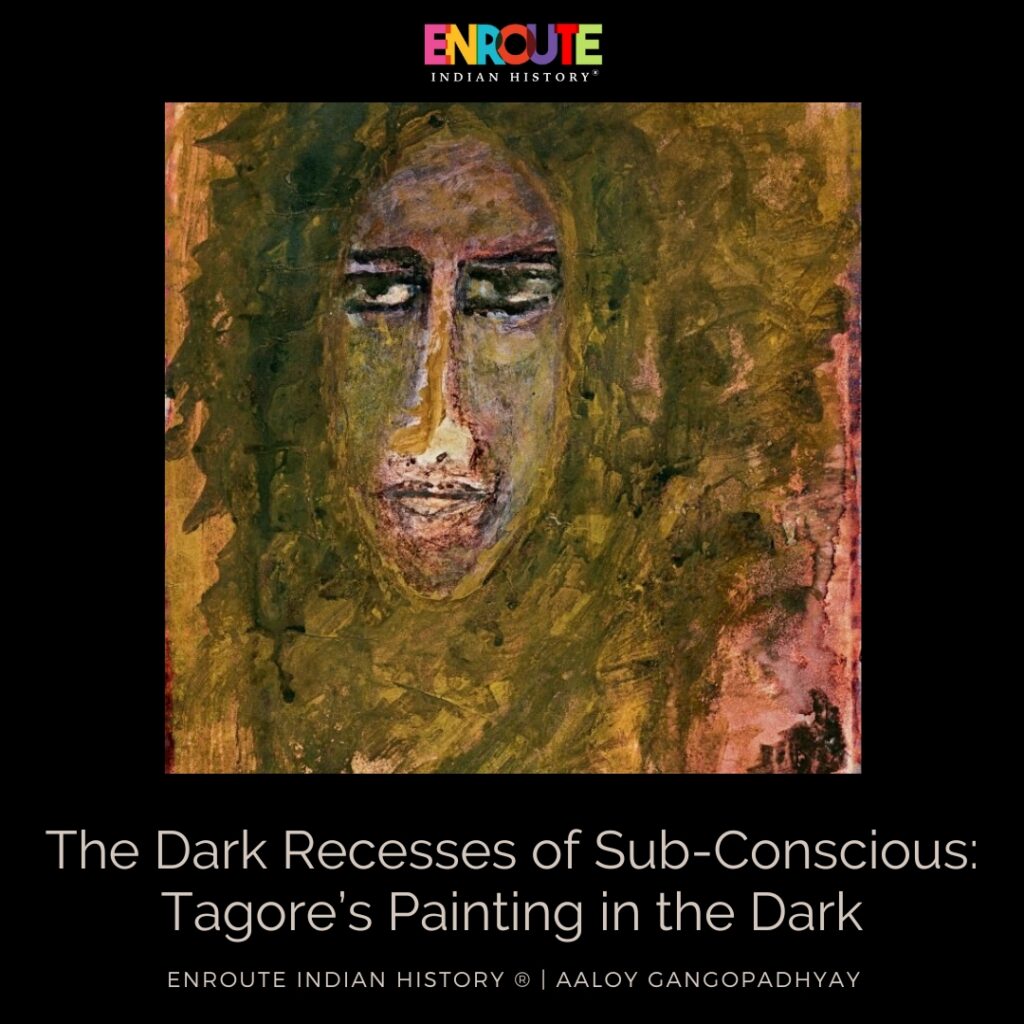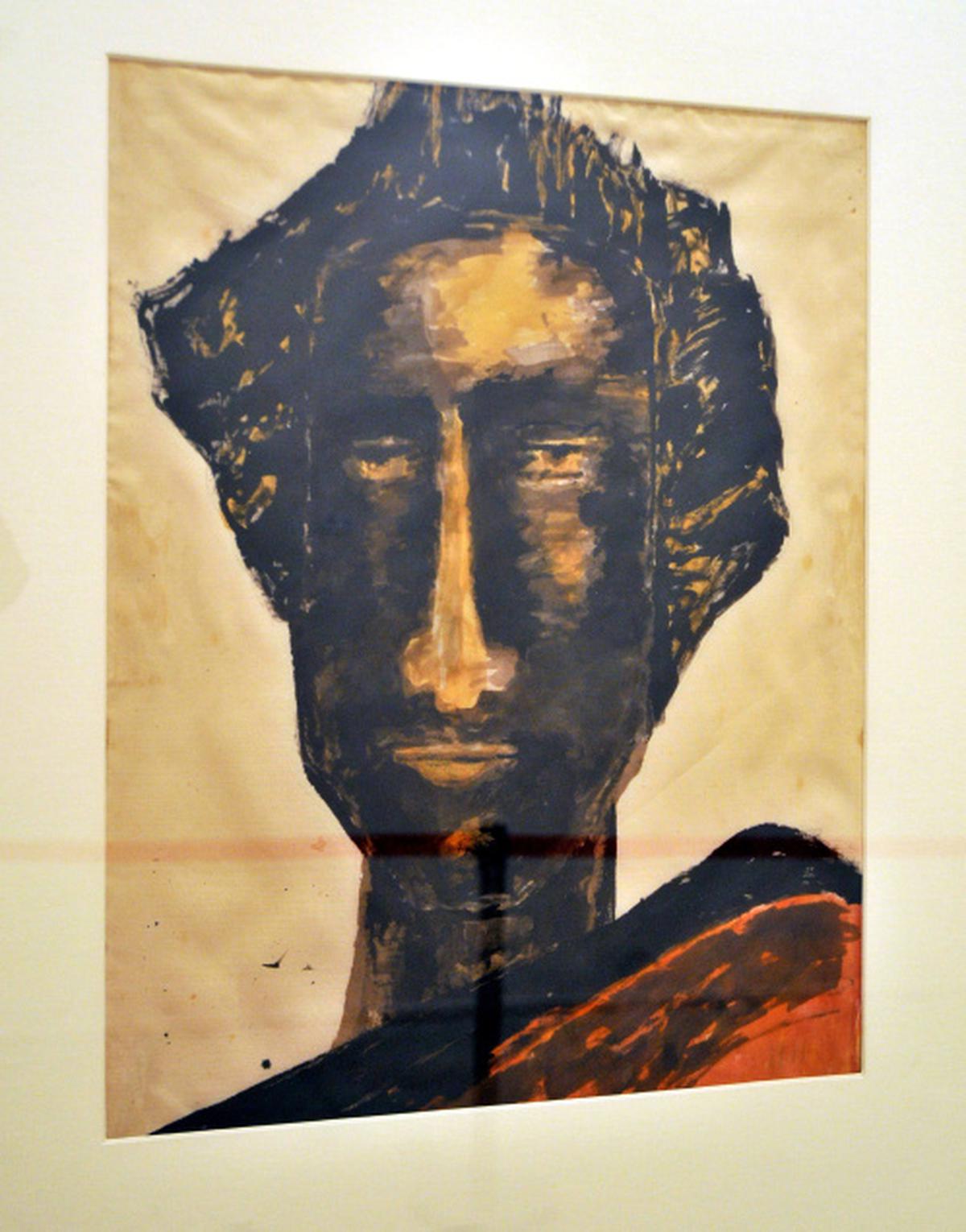
Article Written By EIH Researcher And Writer
Aaloy Gangopadhyay
Images are the language of the subconscious mind. The subconscious mind thinks and stores memories and experiences in the form of images and symbols. Emotions communicate through images. The best part of the subconscious mind is that it doesn’t categorize, judge or edit thoughts. It is always ready to accept thoughts in the way they come and basically color them. Capable of ingressing deep into the dark recesses of human psyche, Rabindranath Tagore (1861-1941) uttered unequivocally on his paintings: “People often ask me about the meaning of my pictures. I remain silent even as my pictures are. It is for them to express and not to explain.”
At the age of 67 Rabindranath Tagore began wielding the brush. A creative genius and a philosopher of his stature, was mature enough to critically correlate the art and the subconscious that leads to the creation thoughts, and desires lurking in the subconscious. “True art” is created from a place of passion, and acts as an agent of emotional relief, for both the artist who created the painting and those onlookers who resonate with it once complete. A visionary piece of art, can communicate an emotion through time, and resonate on a deep emotional level with someone hundreds of years later. Tagore poignantly envisioned it: “We who have traded in lyrics should know that these will not find acceptance at another time. This is inevitable. So I often think that only painting has a deathless quality.” He spoke of his onrush into art: “Now in the evening of my life my mind is filled with forms and colours.”
Tagore often described his art as “an affair in the evening of life.” From 1926 onwards he devoted more and more time to painting with lines and colours becoming a passion for him. He turned out to be a prolific painter who held nine exhibitions in major cities in Europe and also in Boston and New York between May and December 1930. The opus of approximately 3,000 drawings and paintings, done between 1926 and 1940, trace the extraordinary journey of an artistic expression through the exploration of the subconscious mind. As if he is drawing on Sigmund Freud’s theories of psychoanalysis.
Rabindranath Tagore himself has not aided his audience in the interpretation of his works, desisting from even giving a title to most. He did not come under the spell of any specific artist nor did he adopt any school of style. He never faced the hindrance that formal training can sometimes bring in the way of freedom and vitality of imagination of the artist. As a painter he did not even made preparatory sketches. The images flowed as spontaneously as leaves come to trees.
Rabindranath discovered himself as a painter in the pages of his manuscript: “When the scratches in my manuscript cried, like sinners for salvation, and assailed my eyes with the ugliness of their irrelevance, I often took more time in rescuing them into a merciful finality of rhythm than carrying on what was my obvious task,” he wrote in an introduction to a brochure of an exhibition.


Manuscripts: the beginning
There are distortions and varied facial expressions of physiognomic features with such as a disgust, laughter, grimace, and so on. In the ‘Head’ series, his graceful female figures are in contrast to the masculine heads, where we find a greater variety ranging from the grotesque to tragic. Tagore painted with pen-and-ink drawing of heads towards his later years, with mastery over line and tone. Like a common thread, a leitmotif, his works, even his early landscapes were in black ink.
Tagore’s stylistics and progression were same as when the subconscious does the drawing. He started with an abstract background. Sometimes he left part of his art to chance. It is followed by a relaxed intuitive work, outlining the contours of shapes. Then he painted the background, making color adjustments and adding details. To Freud, “when an individual taps into the forgotten memories of the subconscious, they open a vault of information, feelings, and facts that they may have otherwise been unaware of since they’re not an explicit part of our conscious.” Tagore was able to articulate them in his paintings. He aptly quoted from T.S. Eliot to render his own: “There are two kinds of reality in the world. One of them is true and the other truer. I seek to occupy myself with the truer.”

From an aesthetic transformation of the scratches and corrections in his manuscript, he started primitivist form-making, making zoomorphic patterns in monochrome. Experiments with colours, the media and themes followed. In 1930, the first public exhibition of his works was held. The archives at Visva- Bharati, the largest collection of his paintings anywhere in the world, have a repository of 1,500 in a multitude of styles — pen-and-ink figurations, coloured productions with inks, crayons, pastels, vegetable colours and even varnishes, and finally his monochrome drawings. He has a repository of faces —cynical, sad, youthful, mask-like or resigned. There are distortions but they are not deliberate. Whenever anatomical changes or variations of form and proportions that take place they happen through a process of “rhythmic automatism.”

“The phantoms of faces, come unbidden into my vacant hours,” Tagore wrote of his inspiration in Chitralipi , the book of his paintings that appeared in his lifetime.
Jayanta Chakrabarti in a book picked up from an art collection of Kala Bhavan, the department for visual arts at Visva Bharati, writes “He made experiments with male faces — some of them looking like distortions or caricature. The female faces, on the other hand, were less amenable to such extreme distortions and were invariably gloomy, depressed and sad.” Gradually Tagore started using intense colours to captivate his audience with portraits that emanate a sense of enigma. In The Art of Rabindranath Tagore, Sotheby’s writes, “Unlike most of his individual faces which engage directly with the viewer, this one seems to be looking at something beyond. There is a wordless theatre at play here which teases us into an empathetic immersion.”

In Tagore’s output, the human face is a noticeable constant. Tagore’s faces reveal a myriad of moods like mysterious, melancholic, romantic, menacing, and melodramatic. Tagore’s work in general is imbued with sadness. His mother died when he was a boy, followed by continued personal tragedy. He was down with grief, first, after the suicide of his sister-in-law and literary companion, Kadambari Devi, and then, the years between 1902 and 1907, saw the deaths of his wife, daughter and youngest son. Most of the landscapes showed nature bathed in the evening light, skies and forms coagulating into ominous silhouettes. His landscapes invoke a sense of disquiet and silence.
Tagore does not resemble the modern trendy subconscious mind paintings, namely, John Ashton’s “Subspace Mind – Shifting Planes” and “Entering the Lucid Dream” or “A Tiptoe Through the Subconscious” by Rene Magritte or RC DeWint’s “Optimist” or “Bird” by Tamara Shemyakin or of” Thinking In Pieces” by Igor Karlo or of Carolyn Oberst’s “Signals From Parts Unknown.” Rather Tagore’s female figures, their gentle eyes, melancholy faces, the pain, the lingering pathos came back again and again with the head clothing flowing in mellow colours transmitting dream into reality.

Above is one such painting, an exceptional case in point. It perfectly demonstrates Tagore’s talent of metaphorical painting. The woman, painted in a multi-chromatic scheme, brushed with offset on the left of the picture level. The negative space consists of assorted tempered hues of green, ochre and a dull pink. The gleam of facial light, emerging from darkness at dawn, a dawn which spreads over the horizon in pink and gold: “the hour of silence when nothing moves except light.”

“The human face is a prominent constant in his artistic works and speaks of his undying interest in human persona. The writer Tagore and the painter Tagore found a similar opportunity: connecting human appearance with emotions and essence. His painted faces speak of intrinsic human emotion. His faces give an array of shimmering moods: brooding, romantic, mysterious and dramatic; of fear and melancholia flavoured by wonderment. Most of the women he painted are veiled, saris symbolising a graceful but closeted existence, with covered hands and bodies under folds or veils of the Bengali women of his time,” noted, art critic Vidushi Trivedi. Their sad eyes, and the dark subconscious shadows behind their faces suggest their helpless inexpressibility. What his literary canon and world of music did not find scope to render, Rabindranath captured such sense of existential dread in his canvas.
Bibliography
Art: An Expression of the Mind: J L Burger
Conscious Art vs. Sub-Conscious Art: Judith Robin
The Mystic of Our Subconscious Mind
Crisis in Psychoanalysis: Sigmund Freud
Tagore, the artist: K. C. Chitrabhanu
Tagore Treasures:Twelve paintings by Rabindranath Tagore
Ranger Rabindranath by Ketaki Kushari Dyson and Suśobhana Adhikārī
Bageswari Shilpo Probondhaboli by Abanindranath Tagore
Web References
https://insightscare.com
www.outlookindia.com/photos
www.thehindu.com/



















